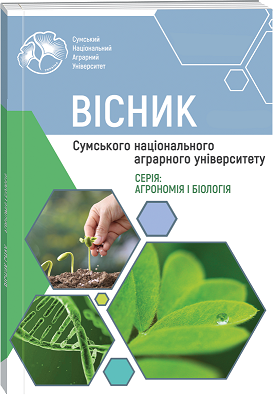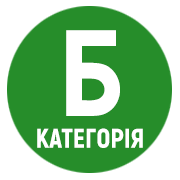BIODIVERSITY OF THE BALK SYSTEM OF TERESHKIVKA VILLAGE (SUMY DISTRICT) AS A PERSPECTIVE ENVIRONMENTAL AND RECREATIONAL TERRITORY
Abstract
The article is devoted to the study of biodiversity of the balk system of Tereshkivka village (Sumy district), in order to assess its sozological, scientific, educational, aesthetic and recreational value and give this area environmental status. The field studies of the balk system, which is located northeast of the village Tereshkivka of Sumy region and covers an area of about 140 ha, was carried out during 2019–2020 using classical geobotanical and zoological methods. Along the study area there are agricultural lands, which include the slopes of the balk, that threaten the integrity of landscapes and is the cause of soil erosion. Phytocenoces differ significantly in different parts of the balk due to differences in ecological and coenotic conditions. The southern (closed to the village) part of the balk is a system of dry meadow lands formed on the bottom and on the slopes of the balk, which are at different stages of pasture digression. These are mostly herbaceousfescue groups with dominance in some areas of Festuca ovina L. and in some areas of Agrimonia eupatoria L. A population of the regionally rare species Jurinea cyanoides (L.) Reichenb., which is also included in Annex I of the Berne Convention, was found in the area of the steep slope of the northeastern exposition balk as a part of Agrostis stolonifera plant coenosis. In the branches of the central part of the balk the presence of two territorially separated populations of the valuable medicinal plant – Chamerion angustifolium (L.) Holub. was noted. A regionally rare species of Salix rosmarinifolia L. has been found in the northern part of the balk. In the fauna list, among the invertebrates and birds, there are regional rare species, which according to the IUCN status belong to the LC categories, and among birds a significant number of species are listed in Annex II of the Berne Convention. Mammals are represented mainly by a variety of rodents. Among the reptiles there is Lacerta agilis species – the species from the Annex II of the Berne Covention and according to IUCN has the status of LC. So, the presence within the studied balk system of the species representing a rare component of biodiversity, high species richness, significant reserves of medicinal plants, as well as taking into account scientific, cognitive, environmental, educational and recreational value, we consider that balk system located near the village Tereshkivka is a perspective protected area for the creation of landscape reserve of local importance.
References
2. Boychenko, R. V., Vertel, V. V., Karlyukova, O. Yu., Panchenko, S. M., Kryvozub, I., Dudchenko, G., Kulyzhko, I., Kubrakov, S., Stryzhak, A., & Yakovenko, O. (2019). Pryrodno-zapovidnyi fond Sumskoi oblasti: Atlas-dovidnyk (2yi-e, vypr. ta dopov. vyd.) [Nature Reserve Fund of Sumy Region: Atlas-Handbook (2nd ed., Corrected and supplemented ed.)]. TOV «Ukrainska Kartohrafichna Hrupa», Kyiv, 96 (in Ukrainian).
3. Cardinale, B. J., Matulich, K. L., Hooper, D. D., Byrnes , J. E., Duffy, E., Gamfeldt , L., Balvanera, P., O’Connor, M. I. & Gonzalez, A. (2011). The functional role of producer diversity in ecosystems. American Journal of Botany, 98(3), 572–592. doi: 10.3732/ajb.1000364
4. Caryk, L., & Caryk, P. (2019). Do problemy reguljuvannja rekreacijnyh navantazhen’ ekologo-osvitnih stezhok ustanov pryrodno-zapovidnogo fondu [To the problem of regulation of recreational loads of ecological-educational paths of institutions of nature reserve fund]. Racional’ne pryrodokorystuvannja i ohorona pryrody Naukovi zapysky, 2, 163–172 (in Ukrainian). doi: 10.25128/2519-4577.19.3.20
5. Grishhenko, V. N. (1997) Provedenie oprosov naselenija dlja sbora faunisticheskoj informacii [Conducting the survey among the public to fauna information collecting]. Oblіki ptahіv: pіdhodi, metodiki, rezul’tati, L’vіv, Kiїv, 72–75 (in Russian).
6. Dornelas, M. (2010). Disturbance and change in biodiversity. Phil. Trans. R. Soc. B365, 3719–3727. doi: 10.1098/rstb.2010.0295
7. Dupuy P., Viñuales, J. (2018). International Environmental Law (2nd ed.). Cambridge: Cambridge University Press. doi: 10.1017/9781108399821
8. Govorun, O. V., Sira, O. Je., Vertel’, V. V., & Darmostuk, V. V. (2020). «Vakalivs’ki shyly» ‒ potencijnyj landshaftnyj zakaznyk miscevogo znachennja na Sumshhyni [«Vakalivsky slopes» - projected local nature reserve in Sumy region]. Visnyk SumNAU. Serija Agronomija i biologija, 2020, 1(39), 19–25. doi: 10.32845/agrobio.2020.1.3
9. Heobotanichne rajonuvannja Ukrai’ns’koi’ RSR / AN URSR, (1977) [Geobotanic zoning of Ukrainian SSR]. In-t botaniky im. M. G. Holodnogo. Nauk. dumka, Kyiv (in Ukrainian).
10. Hellweg, S., Mila, I., & Canals, L. (2014). Emerging approaches, challenges and opportunities in life cycle assessment. Science, 344 (6188), 1109−1113. doi: 10.1126/science.1248361
11. Jakubenko, B. Je., Popovych, S. Ju., Utymenko, P. M., Dubyna, D. V., & Churylov, A. M. Heobotanika: metodychni aspekty doslidzhen’. (2018). [Geobotany: methodological aspects of research]. Vyd-vo Lira-K, Kyiv (in Ukrainian).
12. Kaur, A. (2018) Conservation of Plant Biodiversity Current Strategies and Future Needs. International Journal of Scientific Research in Biological Sciences, 5(4), 109–113. doi: 10.26438/ijsrbs/v5i4.109113
13. Marynych, A. M., Pashhenko, V. M., & Shyshhenko, P. G. (1985). Pryroda Ukraynskoj SSR. Landshafty y fyzykogeografycheskoe rajonyrovanye [Nature of Ukrainian SSR. Landscapes and physico-geographical zoning]. Nauk. dumka, Kyi’v.
14. Metodychni rekomendacii’ shhodo vyznachennja maksymal’nogo rekreacijnogo navantazhennja pryrodnyh kompleksiv i ob’jektiv u mezhah pryrodno-zapovidnogo fondu Ukrai’ny za zonal’no-regional’nym rozpodilom [Methodical recommendations for determining the maximum recreational load of natural complexes and objects within the nature reserve fund of Ukraine by zonal-regional distribution] (2003). Kyi’v, 43 (in Ukrainian).
15. Movchan, Ja. I. (2000). Zberezhennja biorozmai’ttja Ukrai’ny (kontekst ekopolityky) [Conservation of the biodiversity of Ukraine (ecopolitics context)], 18, II, Naukovi zapysky NaUKMA, Kyiv (in Ukrainian).
16. Nacional’nyj plan dij ohorony navkolyshn’ogo pryrodnogo seredovyshha do 2025 roku [National plan for the protection of the natural environment until 2025]. [Electronic resource]. Access mode: https://www.kmu.gov.ua/npas/pro-zatverdzhennyanacionalnogo-planu-dij-z-ohoroni-navkolishnogo-prirodnogo-seredovishcha-na-period-do-2025-roku-i210421-443
17. Polevaya geobotanika. (1959). [Field geobotany]. Izdatel’stvo Akademii Nauk SSSR, Moskva, 1 (in Russian).
18. Polevaya geobotanika. (1964). [Field geobotany]. Nauka, Moskva-Leningrad, 3 (in Russian)
19. Rahman, M.A. (2018) Plant diversity in Hazarikhil Wildlife Sanctuary of Chittagong and its conservation management. Journal of Biodiversity Conservation and Bioresource Management, 3(2), 43–56. doi: 10.3329/jbcbm.v3i2.36027
20. Segelbacher, G. (2018). Genetic, genomic, synthetic - new approaches for biodiversity conservation. Proceedings of the 5th European Congress of Conservation Biology. ECCB2018: 5th European Congress of Conservation Biology. 12th–15th of June 2018, Jyväskylä, Finland. doi: 10.17011/conference/eccb2018/107508
21. Sheljag-Sosonko, Ju. R., Ustymenko, P. M., & Popovych, S. Ju. (1992). Strategija polifunkcional’noi’ ohorony pryrodnyh terytorij [Strategy of multifunctional protection of natural territories]. Tezy dopov. IH z‘i’zdu UBT. Naukova dumka, Kyi’v, 174–175 (in Ukrainian).
22. Sheljag-Sosonko, Ju. R. (2001). Bioresursy: stan ta analiz dysbalansiv [Bioresources: status and analysis of imbalances]. Pryrodno-resursnyj aspekt rozvytku Ukraïny. KM Academia, Kyiv, 40–74 (in Ukrainian).
23. Sklyar, V. H., & Sklyar, Yu. L. (2003). Systemnyy pidkhid do optymizatsiyi okhorony pryrodnykh kompleksiv [Integrated approach to optimization of protection of natural complexes].Ukrai’ns’kyj botanichnyj zhurnal, 60(4), 388‒396 (in Ukrainian).
24. Sklyar, V. H., & Sklyar, Yu. L. (2014). Stvorennya novykh terytoriy pryrodno-zapovidnoho fondu yak vazhlyvyy skladnyk rozbudovy strukturnykh elementiv ekomerezhi Polis’koyi chastyny Sums’koyi oblasti [Creation of new territories of the nature reserve fund as an important component of the development of structural elements of anecological network of the Polissia part of Sumy region]. Naukovyy visnyk Skhidnoyevropeys’koho Natsional’noho universytetu im. Lesi Ukrayinky. Seriya «Biolohichni nauky», 13(290), 61‒66 (in Ukrainian).
25. Sklyar, V. G., Sklyar, Ju. L., Bashtovyj, M. G., Lytovka, V. V., Jemec’, O. M., Sherstjuk, M. Ju., & Jaroshenko, N. P., Goven’ko Ja. S. (2020). Bioriznomanittja proponovanogo zakaznyka «Pshinchyne» [Biodiversity of the proposed reserve “Pshinchyne”]. Visnyk SumNAU. Serija Agronomija i biologija, 3(41), 41–48. doi: 10.32845/agrobio.2020.3.5
26. Smyrnova, S. M., Mas’, Ju. A, Koval’, A. O. (2021). Jevropejs’kyj dosvid zemlekorystuvannja pryrodno-zapovidnogo fondu [European esperience of land use of nature reserve fund]. Ekonomika i derzhava, 1, 77–82. doi: 10.32702/2306-6806.2021.1.77
27. Sui, X., Mao, L., Liu, Y., & He, F. (2018). Mapping relative extinction risk for biodiversity conservation. Biological Conservation, 226, 168–176. doi: 0.1016/j.biocon.2018.07.012
28. Pryrodno-zapovidnyj fond [Nature reserve fund] (2021). Sajt Ministerstva zahystu dovkillja ta pryrodnyh resursiv Ukrai’ny. [Electronic resource]. Access mode: https://wownature.in.ua/oberihaymo/pryrodno-zapovidnyy-fond/
29. Rabosky, D. L., (2009). Ecological limits and diversification rate: alternative paradigms to explain the variation in species richness among clades and regions. Ecology Letters, 12(8), 735–743. doi: 10.1111/j.1461-0248.2009.01333.x
30. Wilsey, B. J. (2018). Biodiversity of Grasslands. Oxford Scholarship Online. doi: 10.1093/oso/9780198744511.003.0002 31. Zakon Ukrai’ny «Pro Osnovni zasady (strategiju) derzhavnoi’ ekologichnoi’ polityky Ukrai’ny na period do 2030 roku» [Law of Ukraine “on the Basic Principles (Strategy) of the State Environment Policy of Ukraine for the period up to 2030”]. (2019). URL: https://zakon.rada.gov.ua/laws/show/2697-19#Text
32. Zlobin, Ju. A., Skljar, V.G., & Klimenko, A.O. (2013). Populjacii redkih vidov rastenij: teoreticheskie osnovy i metodika izuchenija [Population of rare plant species: theoretical foundations and research methods]. Universitets’ka kniga, Sumy, 439 (in Russian).

 ISSN
ISSN  ISSN
ISSN 


